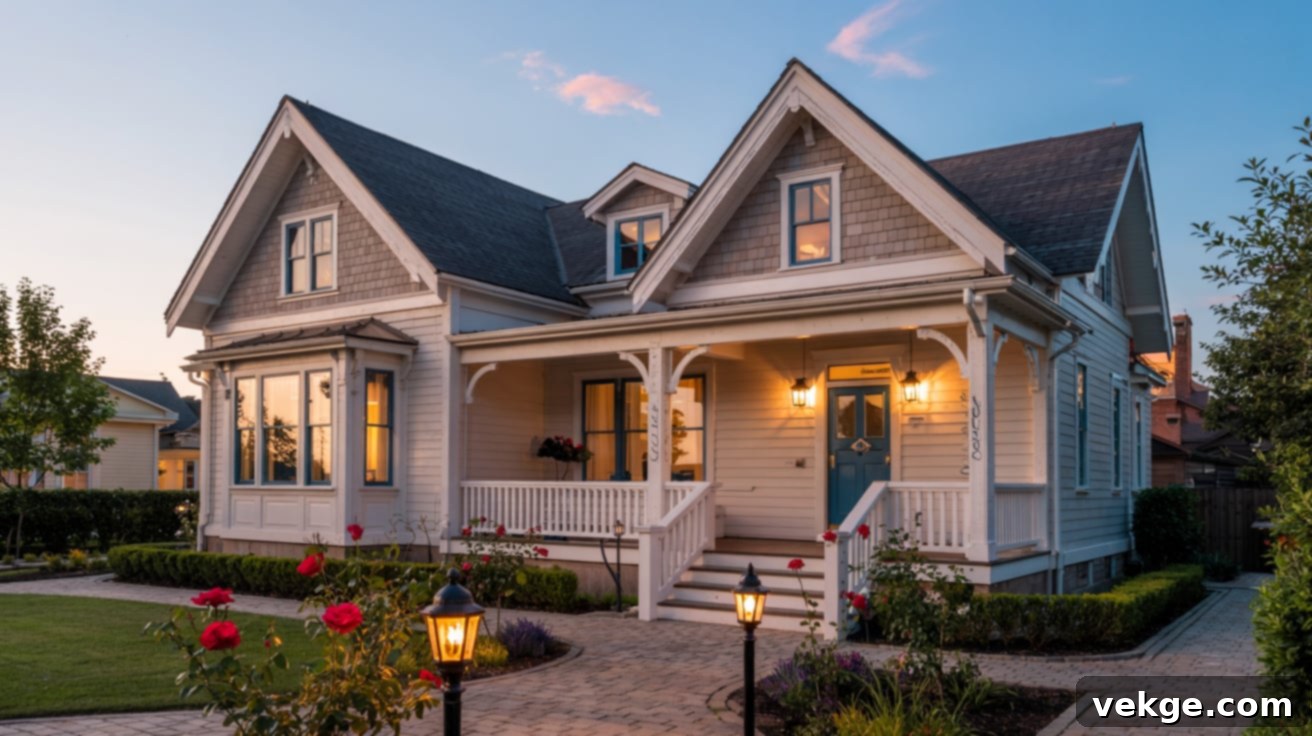Modern Victorian Homes: Blending Historic Elegance with Contemporary Comfort and Smart Design
Have you ever admired the intricate beauty of an old Victorian house, yet wished it offered the practical comforts and technological conveniences of modern living? The dream of a home that respects its rich heritage while embracing today’s lifestyle is no longer just a fantasy. A Modern Victorian home provides this perfect synthesis: classic architectural character fused with contemporary comfort, cutting-edge technology, and unparalleled functionality.
This comprehensive guide will walk you through every essential aspect of creating your own Modern Victorian masterpiece. From defining this unique style and selecting the right period-appropriate yet updated details to exploring room-by-room design tips, practical renovation ideas, and eco-friendly upgrades, you’ll find everything you need. Whether you’re embarking on a new build or dreaming of a thoughtful makeover for an existing property, this article is your ultimate source of inspiration and practical advice. Let’s bring your Victorian vision to life, crafting a home that is beautiful, functional, uniquely yours, and perfectly suited for the 21st century.
Understanding the Modern Victorian House Style
At its core, a Modern Victorian house is an exquisite blend of two distinct eras. It marries the ornate, romantic, and often dramatic beauty of 19th-century architecture with the clean lines, efficiency, and streamlined functionality inherent in contemporary design. This style is a conscious celebration of historical craftsmanship—think grand turrets, intricate gingerbread trim, soaring high ceilings, and majestic bay windows—all while seamlessly integrating modern comforts such as expansive open layouts, intuitive smart home technology, and sustainable, high-performance materials. The result is a home that feels both nostalgically charming and refreshingly livable, a true testament to timeless design.
Victorian vs. Queen Anne and Edwardian Styles: A Quick Comparison
While frequently grouped under the broad umbrella of “Victorian,” the Victorian, Queen Anne, and Edwardian architectural styles each possess their own unique defining features and historical contexts. Understanding these distinctions is crucial for anyone looking to accurately identify, restore, or design a home that truly reflects its desired period influence.
Here’s a concise comparison to help you differentiate these styles and apply them effectively based on your design goals and your home’s existing structure:
| Style | Time Period | Key Features | Best Used For |
|---|---|---|---|
| Victorian | 1837–1901 | Steeply pitched roofs, elaborate ornate trim, asymmetrical facades, often dark colors, patterned brickwork. | Authentic restorations, historic urban neighborhoods, creating a sense of grandeur and intricate detail. |
| Queen Anne | 1880–1910 | Prominent circular or octagonal turrets, expansive wrap-around porches, fish-scale shingles, vibrant bold colors, bay windows. | Making a significant exterior statement, whimsical design elements, homes with complex rooflines and varied textures. |
| Edwardian | 1901–1914 | Simpler, less ornate than Victorian, larger windows for more natural light, often red brick, wider and squarer footprint, brighter interiors. | Bright and airy interiors, integrating modern upgrades more easily, suburban settings, a more restrained yet elegant aesthetic. |
Common Misconceptions About Modern Victorian Design
A widespread misconception is that creating a Modern Victorian home requires stripping away its original, historically rich style to achieve a contemporary feel. This couldn’t be further from the truth. In reality, modern interpretations are about enhancing functionality and livability through thoughtful updates, not erasing historic beauty. The goal is to improve without undermining the inherent charm and architectural integrity.
Another common point of confusion arises from lumping Victorian, Edwardian, and Queen Anne styles together interchangeably. While they do share overlapping eras, their architectural intent, specific detailing, and overall forms are distinct. Victorian homes emphasize elaborate ornamentation, while Queen Anne leans into whimsical asymmetry and turrets, and Edwardian favors a slightly simpler, more robust, and lighter aesthetic. Understanding these subtle but significant differences empowers homeowners and designers to make more accurate, respectful, and impactful design choices that truly reflect both individual personality and historical authenticity, ensuring a cohesive and truly modern Victorian aesthetic.
Modern Victorian Design Details: Exterior and Interior Elements
Discover how a Modern Victorian home masterfully achieves a perfect balance between its historic stylistic roots and the demands of contemporary livability, both from its commanding exterior presence to its richly detailed interiors. This section dives deep into creating captivating curb appeal and provides room-by-room inspiration for interior spaces that blend past and present seamlessly.
Exterior Design: Crafting Modern Victorian Curb Appeal
The exterior of a Modern Victorian home is designed to make a truly bold and memorable statement. It’s where time-honored architectural grandeur meets intelligent modern materials and thoughtful design updates. From the intricate trim that whispers tales of a bygone era to the meticulously planned landscaping, the focus is on honoring history while simultaneously enhancing functionality, durability, and aesthetic appeal for years to come.
1. Essential Architectural Elements to Include
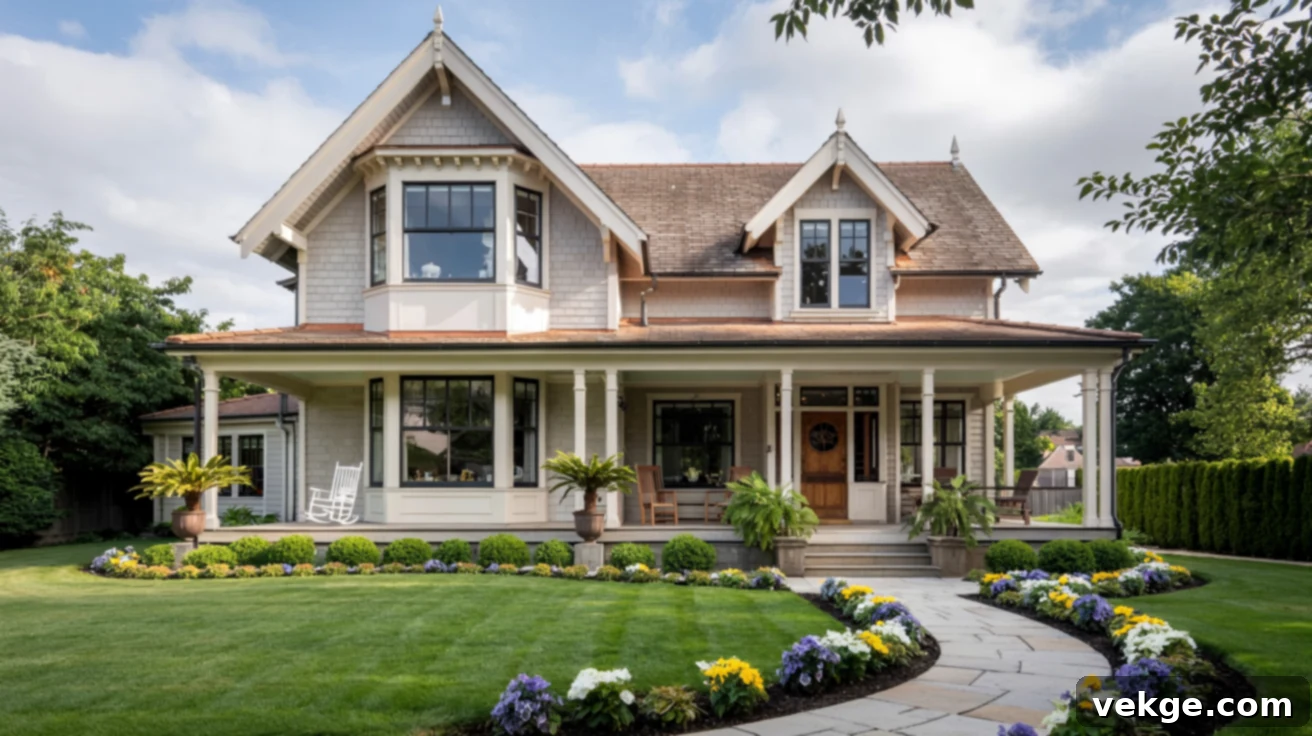
To truly capture the essence of a Modern Victorian, incorporate several key architectural features. Look for steeply pitched gables, which are hallmark elements, along with asymmetrical facades that add visual drama and complexity. Tall, multi-paned bay windows are essential for both interior light and exterior character, while a classic wrap-around porch provides a welcoming space and deepens the historic feel. These elements are vital for preserving the distinctive character of traditional Victorian architecture, adding immense visual interest, and significantly enhancing the home’s curb appeal. Even when constructing a new build, carefully incorporating these details imbues the home with a stately, timeless presence that distinguishes it from more generic contemporary designs.
2. Modern Materials with Classic Looks and Enhanced Durability
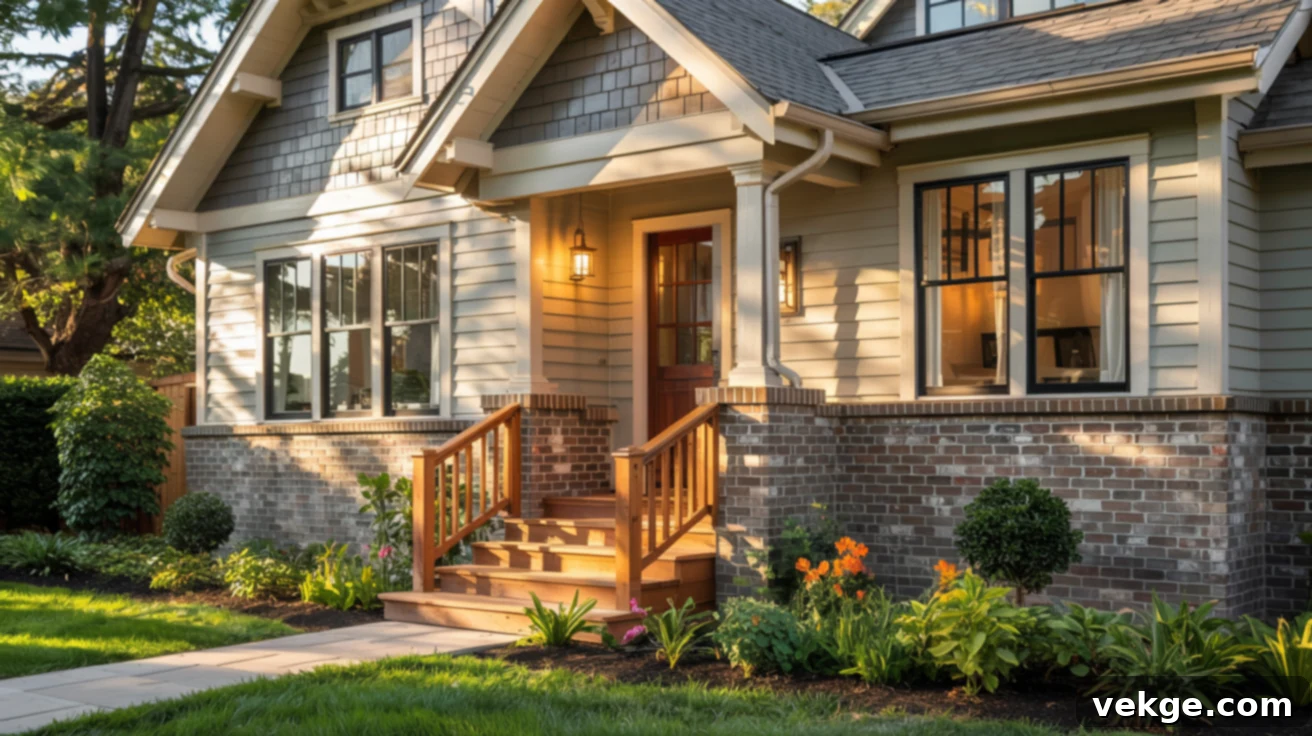
To achieve a modernized Victorian look without sacrificing its inherent beauty, many homeowners and builders are now opting for advanced materials that offer superior performance. Fiber cement siding is a popular choice, as it beautifully mimics the look and texture of traditional wood siding but offers exceptional durability, fire resistance, and minimal maintenance. Sustainable brick, too, provides a timeless aesthetic with enhanced longevity. While natural wood remains a cherished material, it’s often specified with modern treatments and finishes to ensure greater resilience against the elements. These carefully chosen materials provide your home with remarkable longevity and lower maintenance requirements, all without compromising on historical authenticity. Smartly combining them ensures the home meets rigorous modern performance standards while remaining profoundly true to its Victorian roots.
3. Blending Historic Colors with a Modern Twist
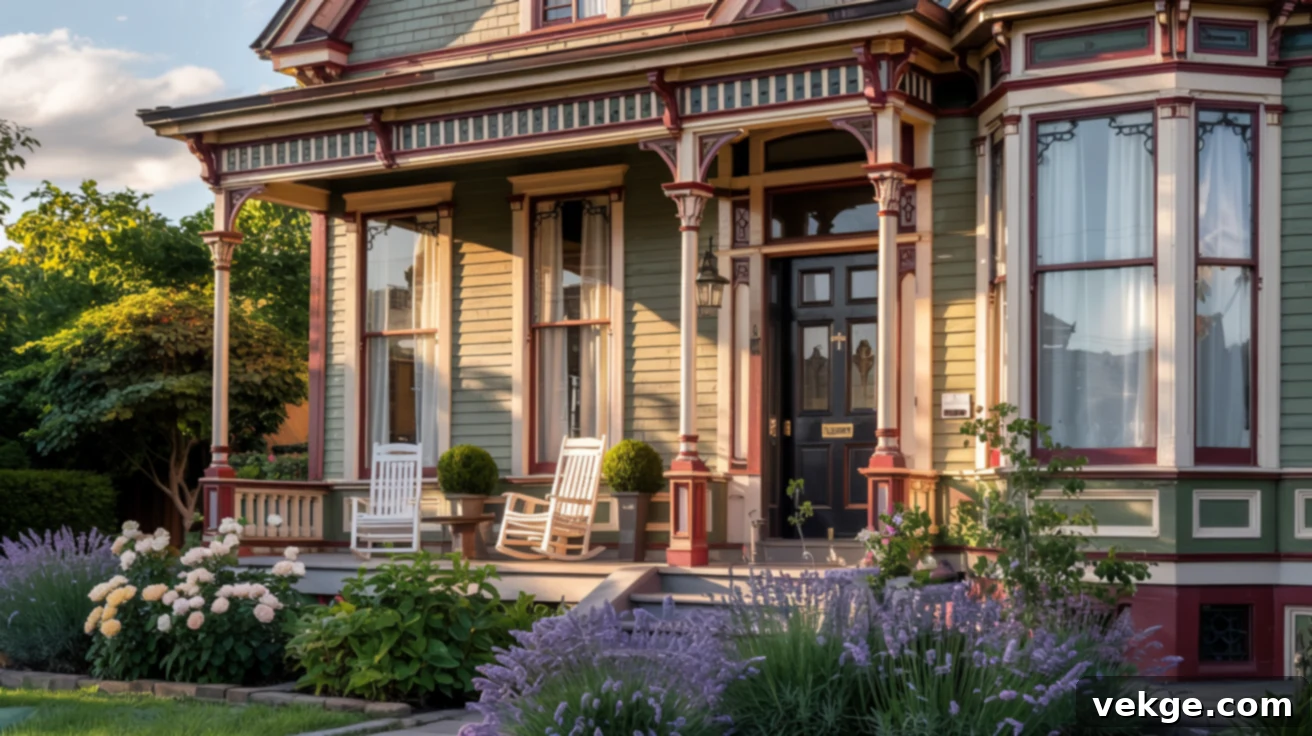
A sophisticated Modern Victorian color palette masterfully blends deep, rich historical hues with fresh, contemporary accents. Consider foundational historical colors such as earthy sage green, elegant deep burgundy, or a calming dusty blue. These can be beautifully paired with modern neutrals like sleek matte black for window frames or railings, and creamy white or soft grey for trim, creating a vibrant yet balanced exterior. These thoughtful color choices respectfully echo the opulent Victorian aesthetic but introduce a sense of freshness and currency. When strategically applied, colors can dramatically highlight intricate trim work, grand porches, and the detailed craftsmanship that defines Victorian architecture, making every element pop.
4. Landscaping and Thoughtful Exterior Lighting
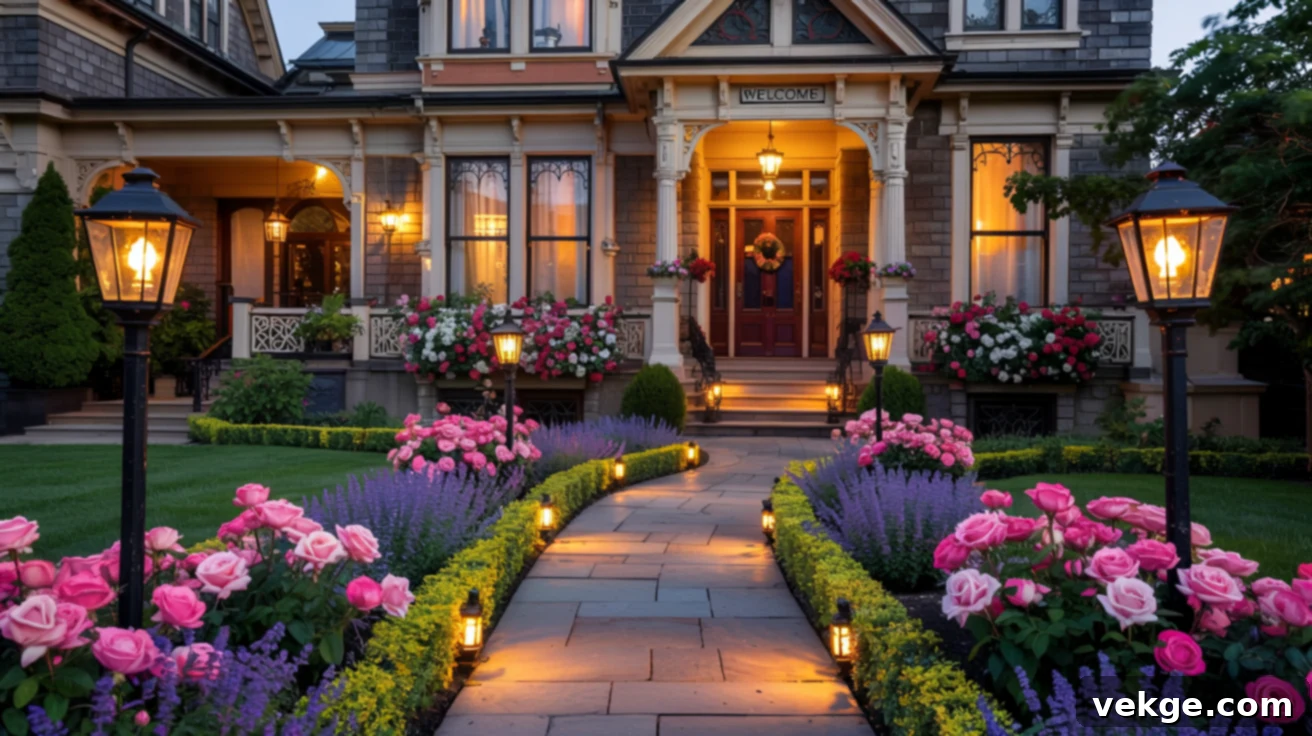
Traditional Victorian landscaping often featured lush, multi-layered gardens with a profusion of flowering plants and winding pathways. For a Modern Victorian approach, you can update this with more symmetrical planting beds, neatly clipped hedges, and strategically placed ambient lighting for a cleaner, more refined aesthetic. Incorporate modern pathway lights that guide visitors, vintage-style lanterns that evoke a sense of history, and flowering borders that seamlessly blend historical charm with contemporary appeal. This thoughtful combination not only creates a dramatic and welcoming entrance but also significantly improves night-time curb appeal, all while remaining true to the classic beauty of the architectural style.
Interior Design: Room by Room Modern Victorian Ideas
Modern Victorian interiors are characterized by their rich textures, opulent finishes, and striking contrasts. They expertly pair smart technology and clean, uncluttered layouts with intricate ornate trim, plush, luxurious fabrics, and statement lighting fixtures. Each room becomes an opportunity to celebrate the timeless elegance of the past while providing the ultimate in contemporary comfort and versatile usability, catering to the demands of modern family life.
5. The Inviting Living Room
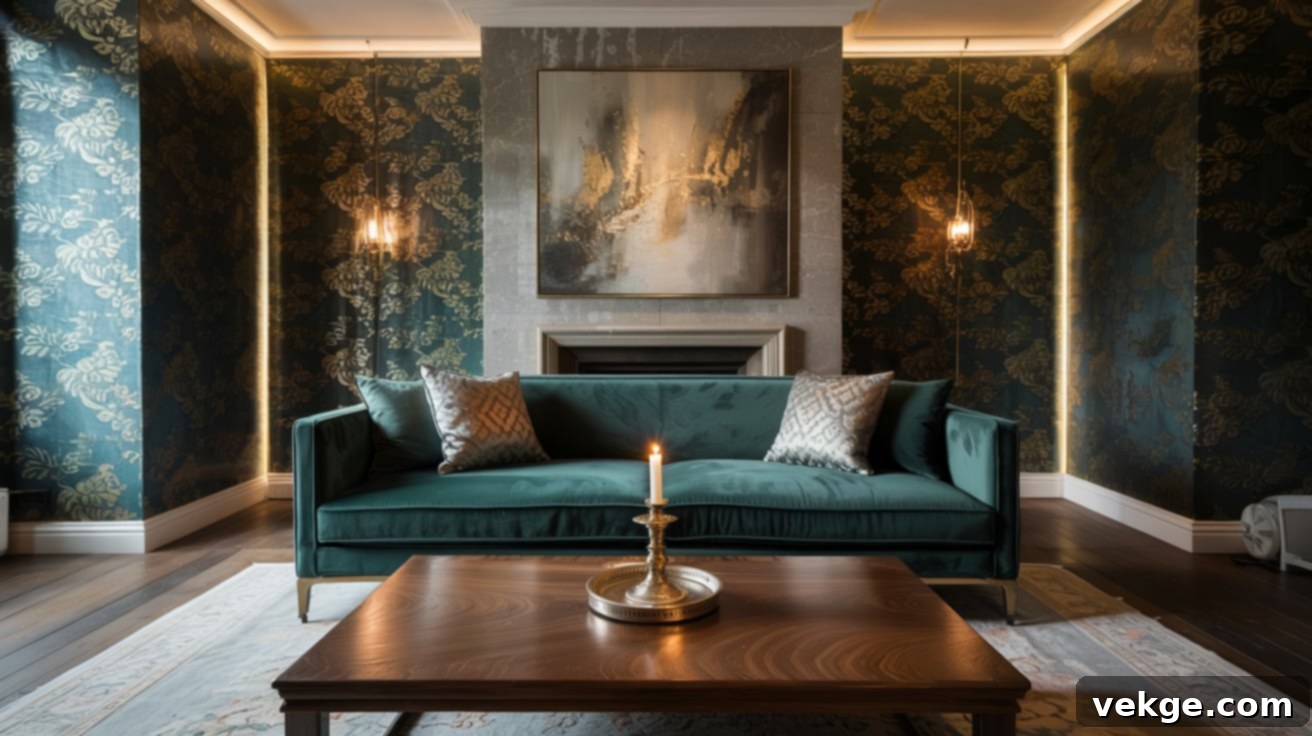
The living room often serves as the heart of a Modern Victorian home, setting the tone for the entire interior. Here, you can achieve a captivating balance by mixing antique-inspired furnishings with seamlessly integrated sleek technology. Picture sumptuous velvet seating in deep jewel tones, complemented by dark wood coffee tables and bookshelves. Concealed bright lighting, perhaps with smart dimmers, can illuminate the space when needed, while more decorative fixtures provide ambiance. A Modern Victorian living room strikes a delicate balance between ornate wallpaper or intricate crown molding and minimalist furniture arrangements. This approach creates a space that feels both undeniably luxurious and wonderfully uncluttered, perfectly tailored for today’s sophisticated lifestyle and entertaining needs.
6. The Functional and Elegant Kitchen
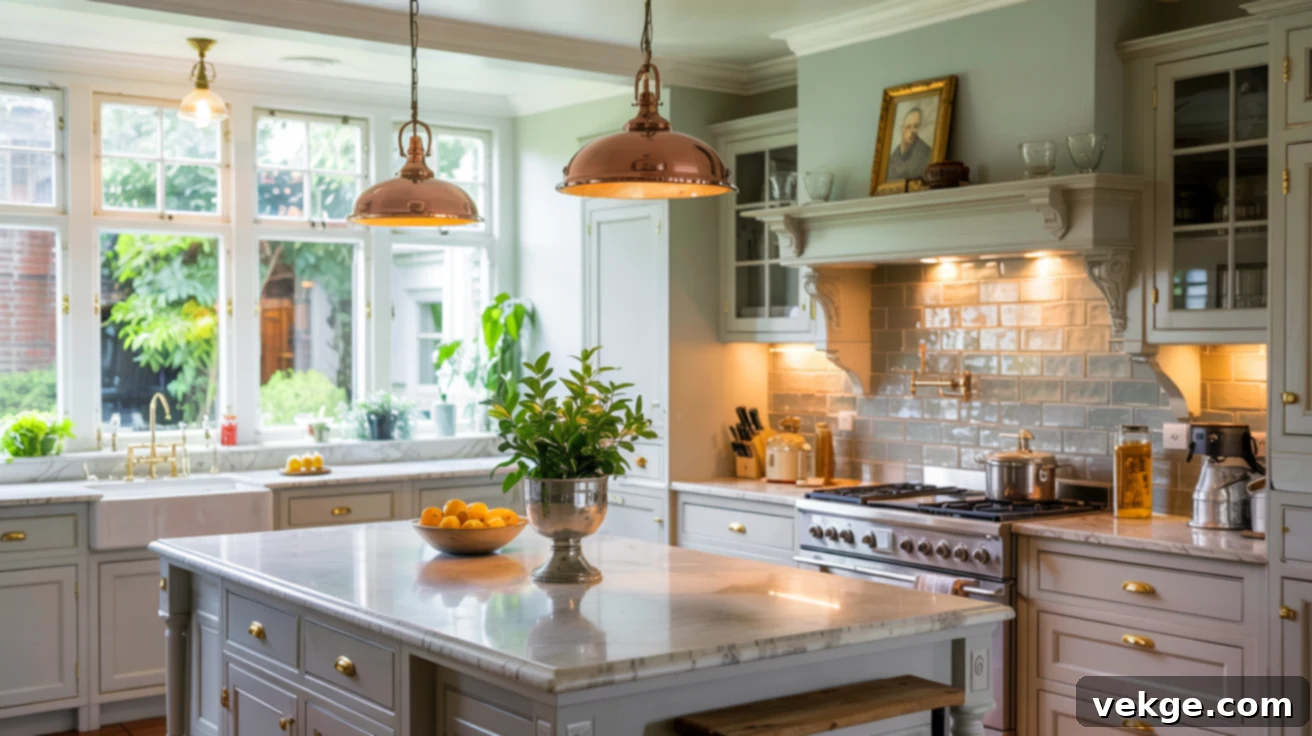
A Modern Victorian kitchen is a testament to form meeting function beautifully. It typically blends classic Shaker-style or paneled cabinetry, often in deep, rich colors or elegant creams, with sleek, durable countertops made from quartz or marble. High-tech, integrated appliances provide all the modern conveniences without detracting from the aesthetic. Vintage-style fixtures, such as elegant pendant lighting over an island or retro brass handles on cabinets, firmly anchor the space in its historical roots. Incorporating an open-concept design, large functional kitchen islands for prep and casual dining, and soft, patterned backsplash tiles ensures the kitchen remains highly functional and a central gathering point without ever losing its distinctive historical soul or charm.
7. The Luxurious Bathrooms
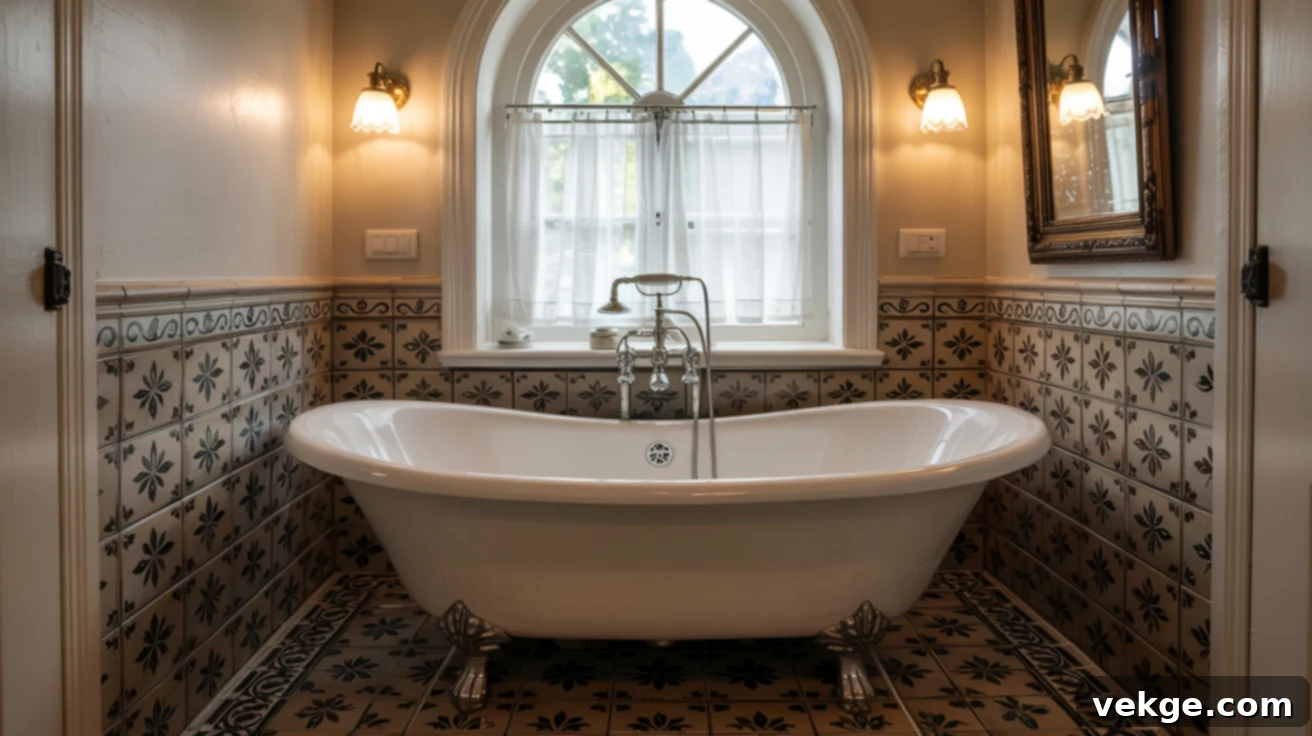
In a Modern Victorian bathroom, classic elegance meets spa-like comfort. Iconic clawfoot tubs and intricate tile patterns—such as checkerboard, geometric, or floral motifs—provide an immediate vintage flair. These traditional elements are then wonderfully contrasted with modern conveniences like touchless faucets, rain showers, and luxurious radiant heated floors. Use bold, statement wallpaper or stylish, period-inspired sconces to inject a distinctive touch of Victorian personality and warmth. This thoughtful mix transforms the bathroom into a serene and relaxing retreat that not only pays beautiful homage to the past but also offers every conceivable comfort and modern amenity, making it a true sanctuary.
8. The Tranquil Bedrooms
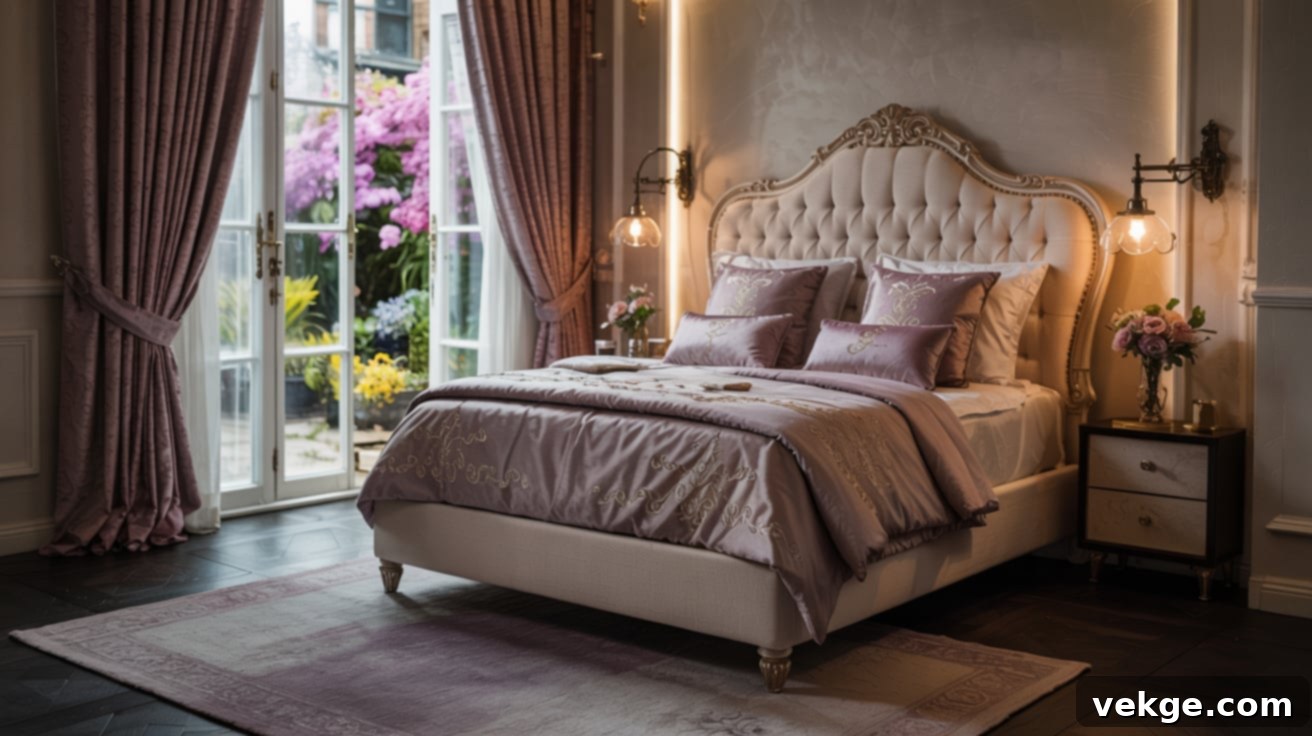
High ceilings and generously sized windows are defining features that instantly establish the Victorian feel in a bedroom. This grandeur is beautifully enhanced by layered textiles, such as opulent tufted headboards, exquisitely embroidered bedding, and heavy, dramatic curtains that frame the windows. Modern touches can be introduced through strategically placed bright, direct lighting, soft LED uplighting for ambiance, or minimalist nightstands that offer a clean counterpoint to the more elaborate elements. The harmonious result is a cozy yet incredibly stylish bedroom that feels both classic in its timeless appeal and entirely contemporary in its comfort and functionality, offering a perfect haven for rest and relaxation.
9. Lighting, Flooring, and Essential Decor Details
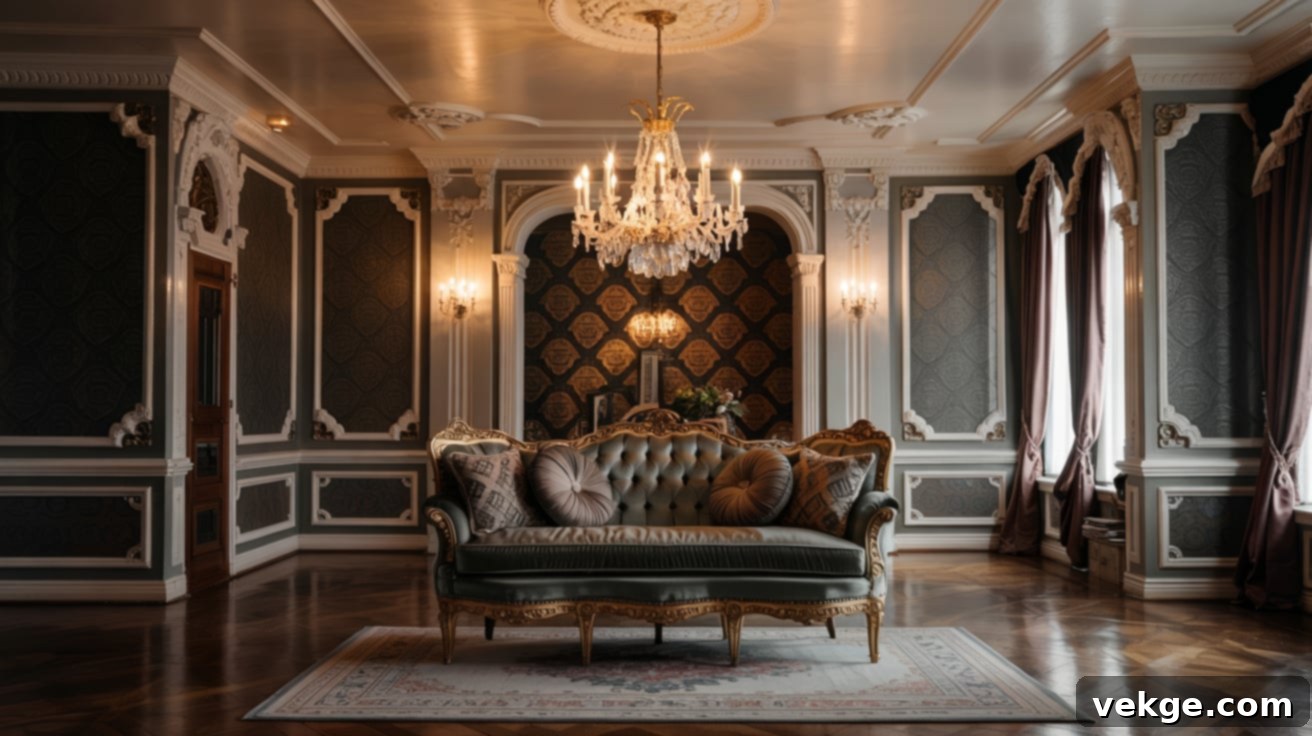
The smaller details often make the biggest impact in a Modern Victorian home. Use statement chandeliers or elegant Victorian-style sconces to infuse personality and sophisticated illumination into your spaces. Hardwood floors, especially in classic patterns like herringbone or rich, dark-stained planks, instantly elevate the historic look and provide a durable foundation. Incorporate decorative moldings, wainscoting, carefully chosen wallpapered accent walls, and ceiling medallions to highlight architectural details and add layers of visual interest. These seemingly small choices collectively elevate the interiors, creating a cohesive and stunning showcase of the Victorian-modern fusion, truly bringing the entire aesthetic together.
Planning & Building a Modern Victorian Home
Embarking on the journey of building a Modern Victorian home involves carefully striking a balance between evoking nostalgic architecture and integrating contemporary convenience. This crucial section will guide you through the initial planning stages, key design considerations, the vital process of hiring the right professionals, and navigating the legal landscape, whether you’re planning a brand-new construction or undertaking a significant renovation.
Building a Modern Victorian from the Ground Up
Yes, constructing a Modern Victorian home entirely from scratch is absolutely possible and offers incredible creative freedom, though it requires meticulous planning and attention to detail. Your first step should involve thoroughly researching local zoning regulations, understanding lot size limitations, and familiarizing yourself with any architectural guidelines, especially if your property is situated in or near a historic district where more stringent restrictions may apply. While modular homes can present a quicker and potentially more budget-friendly option, they often come with limitations on design flexibility and custom Victorian details.
If your vision demands complete creative control, a custom build is the ideal path. This allows you to perfectly blend Victorian grandeur with modern open layouts, ingenious smart technology integrations, and sustainable, energy-efficient features. The result is a truly timeless yet future-ready home that is uniquely tailored to your desires and built to stand the test of time.
Modern Victorian House Plans Overview
Modern Victorian home plans offer remarkable flexibility, designed to beautifully blend traditional charm with essential contemporary functionality. This adaptability makes them perfectly suited for a diverse range of inhabitants, from growing families to individual homeowners seeking character and comfort.
- Designs range significantly, from compact two-story cottages that evoke charm to grand, expansive homes complete with iconic turrets and welcoming wrap-around porches.
- Common layouts typically feature 3–5 bedrooms, generously sized and highly functional kitchens, and versatile open living areas that cater to modern lifestyles.
- A core principle of these designs is to preserve the historic integrity and aesthetic appeal of the exteriors while ensuring a smooth, logical, and open interior flow.
- A wealth of pre-designed plans are readily available through specialized architectural sites, online directories, and visual inspiration platforms like Pinterest, offering diverse options.
- For those seeking a truly bespoke solution, custom plans are offered by experienced designers who specialize in the intricate and artful blend of period aesthetics with modern living requirements.
Hiring the Right Architects & Builders for Your Vision
When selecting architects or builders for your Modern Victorian home project, it is paramount to seek out professionals with extensive experience in historic preservation, hybrid design, or bespoke custom builds. Always request a portfolio showcasing examples of their past work, specifically looking for projects that successfully integrate modern systems and conveniences within a classic or historic aesthetic. During initial consultations, articulate your vision with clarity and precision, and inquire specifically about their approach to seamlessly integrating period details while adhering to all current building codes and safety standards.
Be wary of “red flags” such as any pushback on preserving decorative elements, a demonstrable lack of awareness regarding historic design principles, or a tendency to propose overly generic, one-size-fits-all plans. Your ideal partners should be experts who genuinely value both architectural beauty and innovative functionality, ensuring your project is handled with the respect and expertise it deserves.
Legal and Building Code Considerations
Navigating the legal and building code requirements is a critical phase of planning, as these vary significantly by region and municipality. This is particularly true when constructing or renovating a property within or adjacent to a designated historic district. In such areas, you may be required to obtain approval from local preservation boards or historical commissions before any construction can commence. Be prepared for specific limitations regarding façade changes, approved exterior materials, or even the placement of new additions.
Furthermore, consider how modern conveniences like advanced smart home systems, energy-efficient HVAC, or electric vehicle (EV) chargers will be integrated into an older-style framework. Discussions about electrical codes, energy efficiency standards, accessibility requirements, and the permit application process should happen early in the project lifecycle to prevent costly delays and ensure full compliance throughout your build or renovation.
Renovating an Existing Victorian Home
Renovating an existing Victorian home is a delicate art, demanding a careful balance between preserving its irreplaceable historical beauty and skillfully modernizing its functionality for contemporary living. This section delves into what original features to cherish and keep, what elements are ideal candidates for strategic upgrades, and how to remain both budget-conscious and climate-aware throughout the renovation process.
What to Preserve vs. What to Replace/Upgrade
The key to a successful Victorian renovation lies in enhancing functionality while meticulously preserving the home’s inherent beauty. Here’s a strategic guide on what elements to keep and what to wisely replace or update:
|
Preserve & Restore |
Replace or Update Smartly |
|
Original woodwork (intricate moldings, architraves, door/window trims, wall panels). |
Outdated HVAC systems with modern, energy-efficient units for superior comfort and reduced utility bills. |
|
Historic window casings and vintage sash frames (restore or replicate for authenticity). |
Ancient electrical wiring to meet current safety codes and support modern power demands. |
|
Grand staircases and beautifully crafted balustrades (refinish or repair rather than replace). |
Failing plumbing systems with new pipes and fixtures for improved function, water pressure, and reliability. |
|
Decorative crown moldings, ceiling medallions, and plaster detailing. |
Inadequate insulation in walls, attics, and crawl spaces for significantly better thermal performance. |
|
Salvageable architectural features (original fireplaces, solid wood doors, hardware). |
Single-pane windows with energy-efficient replicas that perfectly match the home’s historical style and scale. |
Budgeting and Comprehensive Cost Breakdown
Renovation costs for Victorian homes can vary dramatically, depending extensively on the project’s scope, the age of the home, and its current condition. Light cosmetic updates might require a modest budget, but extensive structural overhauls, major system replacements, or foundation work will inevitably demand significantly more financial resources. It is crucial to factor in potential hidden expenses such as mandatory permits, unexpected repairs for unforeseen damage (e.g., rot, asbestos, lead paint), or the costs associated with bringing outdated features up to current building codes.
The cost of skilled labor, especially for preserving, restoring, or replicating original historical details, can also substantially add to the overall expense. Always allocate a significant contingency buffer (typically 15-20% of your total budget) for unexpected issues. Furthermore, gather multiple detailed contractor estimates and thoroughly vet their experience in historic properties to make truly informed and cost-effective decisions.
Empowering DIY Renovation Ideas for Modern Victorian Style
Many impactful Modern Victorian updates can be tackled by enthusiastic homeowners without necessarily breaking the bank. Start with highly effective and visible projects like painting interior walls in historically inspired, yet subtly modernized, hues. Consider swapping out outdated light fixtures for elegant antique-style chandeliers or sconces. Applying decorative molding or wainscoting to plain walls can instantly add architectural depth and character. Essential DIY tools for these projects include quality paint sprayers for efficient coverage, reliable cordless drills for installations, and various trim kits for precise finishes.
Thrift stores, antique shops, and architectural salvage yards are invaluable treasure troves for finding affordable, period-appropriate hardware, unique decor pieces, and vintage furniture. For more ambitious DIYers, refinishing original hardwood floors or meticulously restoring ornate fireplace mantels can yield incredibly rewarding results and significantly enhance vintage beauty, adding immense value and personal touch to your Modern Victorian space.
Regional and Climate Considerations for Renovations
Victorian homes are found across incredibly diverse climates worldwide, and renovations must thoughtfully reflect local weather conditions and environmental factors. In regions experiencing cold, harsh winters, prioritizing robust insulation upgrades, installing high-quality storm windows, and upgrading to efficient furnace or boiler systems is paramount for comfort and energy savings. For homes in wet or humid climates, selecting moisture-resistant exterior materials, ensuring excellent drainage around the foundation, and incorporating proper ventilation systems are critical to prevent rot and mold.
In hot or dry areas, consider installing UV-blocking window films, using breathable exterior paints that resist cracking, and enhancing attic ventilation to mitigate heat gain. The choice between materials like natural wood versus durable fiber cement siding should be carefully weighed based on local humidity levels, prevalence of pests, and seasonal temperature swings to ensure the long-term protection and resilience of your beloved Modern Victorian home.
Sustainability in Modern Victorian Homes
The remarkable fusion of historic beauty with cutting-edge modern sustainability is not only achievable but also incredibly desirable in a Modern Victorian home. This final section explores effective eco-friendly upgrades, innovative technology integration that respects traditional aesthetics, and valuable certification options that enhance efficiency without ever compromising the timeless charm of Victorian design.
Eco-Friendly Renovation Tactics for a Greener Home
Significantly boost your home’s energy efficiency and environmental footprint through a series of smart, eco-friendly renovation tactics. This includes upgrading insulation to modern, high-performance materials in walls, attics, and crawl spaces. Consider installing sealed, energy-efficient windows that retain heat in winter and repel it in summer, or selecting reflective and recycled roofing materials that reduce heat island effects and divert waste from landfills. These thoughtful, sustainable updates dramatically improve interior comfort, substantially cut energy consumption, and lower utility bills, all while maintaining and even enhancing your home’s cherished historic beauty and appeal.
Smart Tech Integration with a Vintage Feel
You can seamlessly integrate advanced smart home features into your Modern Victorian home without ever compromising its elegant, vintage aesthetic. The key is discreet automation. Choose smart lighting, climate control, and security systems that feature minimal designs or are available with vintage-style finishes that blend effortlessly with your decor. Incorporate dimmable smart bulbs and app-controlled fixtures to perfectly set any mood or ambiance, from bright task lighting to soft, inviting glows. Opt for smart thermostats and security cameras that are either hidden from view or designed with a sophisticated, unobtrusive profile. The exceptional result is a home that feels wonderfully classic in its style and appearance, yet incredibly modern and intuitive in its function and convenience.
Certifications to Consider for Sustainable Value
For homeowners deeply committed to environmental responsibility, pursuing sustainability certifications adds tangible value and undeniable environmental credibility to a Modern Victorian home. Programs like LEED (Leadership in Energy and Environmental Design) reward homes that adhere to stringent sustainable construction and renovation practices, encompassing everything from site selection to indoor air quality. The Energy Star rating applies to appliances, windows, and HVAC systems that meet rigorous high-efficiency standards, ensuring lower energy consumption. Additionally, some specific regions or states offer local certifications or grants specifically tailored for green upgrades to historic properties, providing financial incentives for eco-conscious renovations.
These valuable recognitions not only contribute to significantly lower long-term utility costs and reduced environmental impact but also powerfully reinforce the home’s future resilience, market desirability, and overall resale appeal, making it a wise investment for both your lifestyle and the planet.
Conclusion: Embrace Your Modern Victorian Vision
Now that you’ve journeyed through the intricate ins and outs of defining, designing, building, and renovating a truly spectacular Modern Victorian house, we hope you feel thoroughly inspired and fully equipped to take the exciting next step. Whether your path involves meticulously restoring a cherished classic property or embarking on the grand adventure of building a new home from the ground up, you possess the knowledge to blend timeless beauty with cutting-edge function in a way that perfectly suits your unique lifestyle and aspirations.
You’ve gained invaluable insights into how to respectfully preserve historic details, thoughtfully modernize interior spaces for today’s living, and even integrate sustainable, eco-friendly practices, all while staying profoundly true to the classic design principles that define the Victorian era. The Modern Victorian style is more than just an aesthetic; it’s a philosophy that marries the best of the past with the promise of the future.
Ready to continue shaping your dream home and further refining your vision? Explore more of our expert design tips, innovative ideas, and practical guides across the blog. Let’s continue working together to create a home that not only reflects your exquisite taste but also tells your unique story, beautifully and functionally, for generations to come.
